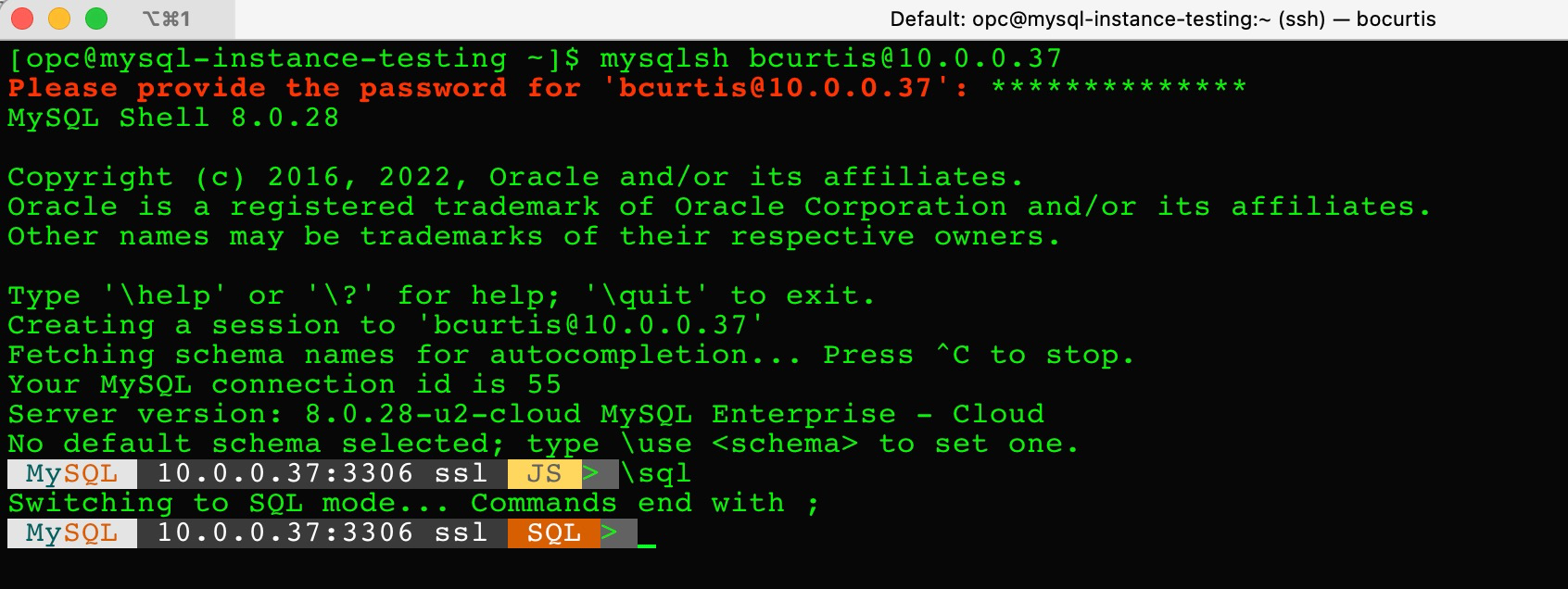With the Oracle Cloud Infrastructure (OCI) MySQL Database Services, in order to connect you have to access MySQL through a compute node. This means you will have to create a compute node within OCI. You can do this quickly with Terraform (here).
Once you have an OCI compute node built, you will need to install MySQL Shell. MySQL Shell is the advanced MySQL Client for Developers and DBAs. Making interaction with MySQL easier from the command line.
Installing MySQL Shell
Access the OCI compute node (needs public IP address of compute node)
> ssh -I .ssh/mysql_private_key.pem opc@<public IP address>

Install MySQL Shell via command line
> sudo yum install -y mysql-shell

After MySQL Shell is installed, you can access your MySQL Database Service (database) via the command line.
Connecting to MySQL
To start MySQL Shell and connect to the DB System endpoint, the following command is used. Keep in mind, you are SSHed into the compute node, from the compute node you’ll use the DB System private IP address to connect.
> mysqlsh [email protected]

Provide the password for the user that was established when creating the MySQL Database Service.
After providing the password, you will be connected to the MySQL Database Service. By default the MySQL Shell will connect you to the JavaScript command line option. I’ve switched to the SQL command line option by using “\sql”.

At this point, you can now interact with your MySQL database on Oracle Cloud Infrastructure (OCI).
Bobby Curtis

I’m Bobby Curtis and I’m just your normal average guy who has been working in the technology field for awhile (started when I was 18 with the US Army). The goal of this blog has changed a bit over the years. Initially, it was a general blog where I wrote thoughts down. Then it changed to focus on the Oracle Database, Oracle Enterprise Manager, and eventually Oracle GoldenGate.
If you want to follow me on a more timely manner, I can be followed on twitter at @dbasolved or on LinkedIn under “Bobby Curtis MBA”.

70918248
References:
health risks of anabolic steroids (https://largesthometrends.com)
70918248
References:
steroid before and after first cycle
70918248
References:
Is Testosterone The Same As Steroids (Sever51.Ru)
70918248
References:
side effects of prolonged steroid use (https://gbx9.com/สล็อตแตกง่าย-แจกจริง/)
70918248
References:
buying steroids Online reviews (http://Www.mindevolution.Lt)
70918248
References:
none (abbet88.com)
70918248
References:
none (Akilah)
Excellent post. I was checking continuously this blog and I am
impressed! Very useful info particularly the last part 🙂 I care for such info much.
I was looking for this certain info for a very long time.
Thank you and good luck.
My page … eharmony special coupon code 2025
Hi! Quick question that’s totally off topic. Do you know how to make your site
mobile friendly? My website looks weird when viewing from my
iphone. I’m trying to find a template or plugin that might be able to fix this problem.
If you have any recommendations, please share. Many thanks!
Also visit my site :: vpn
8xbet
Chơi Cờ Bạc Công Bằng tại k8, Nhận Nhiều Thưởng Hấp Dẫn
Excellent article. Keep writing such kind of information on your blog.
Im really impressed by your blog.
Hi there, You’ve done a great job. I’ll certainly
digg it and individually suggest to my friends. I’m sure they’ll be
benefited from this site. gamefly https://tinyurl.com/23ww4xyv
Excellent beat ! I wish to apprentice at the same time as you
amend your web site, how could i subscribe for a weblog web site?
The account aided me a appropriate deal.
I had been tiny bit familiar of this your broadcast provided bright transparent
concept what is a vpn connection https://tinyurl.com/2bm4xgrn
I don’t think the title of your article matches the content lol. Just kidding, mainly because I had some doubts after reading the article.
is steroids bad
References:
what steroids to take (tellmy.ru)
I’m not that much of a internet reader to be honest but your blogs really nice, keep it up!
I’ll go ahead and bookmark your website to come back later
on. Cheers
Thanks for sharing your info. I really appreciate your efforts and I will be waiting for your further post thank
you once again.
high-roller enticements
References:
Blackcoin.co
how much hgh should a man take
References:
hgh and testosterone (https://md.swk-web.com/pntp-2klrum9Wydp0ulusa)
testosterone and dianabol cycle
References:
sustanon dianabol cycle (Srv29897.ht-test.ru)
dianabol steroid cycle
References:
dianabol deca test cycle (Isowindows.net)
supplements to take with steroids
References:
Steroid transformation (Gitea.Fuluzhanggui.com)
I visited various blogs but the audio quality foor audio songs existing at this website is iin fact marvelous. https://w4I9O.mssg.me/
Thanks ffor finally talking about >Connecting to MySQL Database Service – SSH and MySQL Shell – DBASolved <Loved it! https://Www.bridgewaystaffing.com/employer/tonybet/
Thanks for sharing. I read many of your blog posts, cool, your blog is very good. https://www.binance.info/id/register?ref=GJY4VW8W
Thanks for sharing. I read many of your blog posts, cool, your blog is very good. https://www.binance.com/cs/join?ref=S5H7X3LP